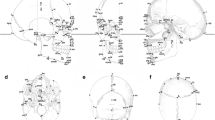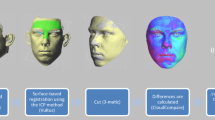Abstract
Objective:
The objective of this study was to check the reproducibility and influencing parameters of landmarks on three-dimensional images of 4- to 6-year-old Caucasian children.
Probands and Methods:
We examined the reproducibility of 22 landmarks on six three-dimensional facial scans of 4- to 6-yearold randomly-selected kindergarten children. The 3D scans were taken by the digital system faceSCAN II® under standardized conditions. One specially-trained investigator marked all landmarks on each of the six 3D scans a total of ten times. Ten different orthodontic residents also placed all landmarks on each of these scans. Standard deviations from the mean were then calculated from the data for each individual landmark on the x-, y- and z-axes.
Results:
The specially-trained investigator who had placed all landmarks on each of the six 3D scans a total of ten times found 15 of 22 landmarks to be reproducible well to within a standard deviation of less than 1 mm on each spatial plane. For the ten orthodontic residents, only three landmarks were found to be reproducible to within a standard deviation of under 1 mm for each spatial plane.
Conclusion:
Familiarity with 3D facial scans and their corresponding software programs, together with good image quality, improve the reproducibility of the analysis. Landmarks revealing poor reproducibility should be used, if at all, with due caution for analysis. It remains to be seen whether they can be omitted altogether, or whether they should be re-set.
Zusammenfassung
Zielsetzung:
Ziel dieser Studie war es, auf dreidimensionalen Fotos die Reproduzierbarkeit von Messpunkten und deren Einflussfaktoren für 4–6-jährige kaukasische Kinder zu prüfen.
Probanden und Methodik:
Auf sechs zufällig ausgesuchten 3DScans von 4–6-jährigen Kindergartenkindern wurden 22 Messpunkte auf ihre Reproduzierbarkeit hin untersucht. Die 3D-Scans wurden unter standardisierten Bedingungen mit dem Digitalisierungssystem faceSCAN II® fotografiert. Ein geeichter Untersucher zeichnete auf allen sechs 3D-Scans alle Punkte insgesamt zehnmal ein. Weitere zehn kieferorthopädische Assistenten zeichneten ebenfalls alle Messpunkte auf diesen Scans ein. Anschließend wurde für die x-, y- und z-Koordinaten eines jeden Punktes die Standardabweichung zu den Mittelwerten bestimmt.
Ergebnisse:
Die Auswertung des geeichten Untersuchers, der auf allen 3D-Scans die Messpunkte zehnmal eingezeichnet hatte, ergab, dass 15 von 22 Punkten in allen drei Raumebenen mit einer Standardabweichung von unter 1 mm gut reproduzierbar waren. Bei den zehn kieferorthopädischen Assistenten gab es nur drei Punkte, bei denen die Standardabweichung in allen drei Raumebenen unter 1 mm betrug.
Schlussfolgerung:
Routine im Umgang mit 3D-Scans und den dazugehörigen Programmen sowie eine gute Bildqualität steigern die Reproduzierbarkeit von Messungen. Punkte, die schlecht reproduzierbar waren, sollten für Auswertungen wenn überhaupt, dann nur mit Vorsicht verwendet werden. In Zukunft muss noch geklärt werden, ob man auf sie vollständig verzichtet oder ob sie rekonstruiert werden müssen.
Similar content being viewed by others
References
The statement of the German Orthodontic Society (DGKFO) on the optimal timing for the performance of orthodontic measures [with special reference to early orthodontic treatment]. J Orofac Orthop 2000;61:381–3.
Bhatia SN, Leighton BC. A manual of facial growth. A computer analysis of longitudinal cephalometric growth. Oxford: Oxford University Press, 1993.
Boldt F, Weinzierl C, Hertrich K, Hirschfelder U. Comparison of the spatial landmark scatter of various 3D digitalization methods. J Orofac Orthop 2009;70:247–63.
Broadbent BH, Broadbent BH, Golden WH. Bolton standards of dentofacial developmental growth. St. Louis: Mosby, 1975.
Farkas LG. Anthropometry of the head and face in medicine. New York: Raven Press, 1994:9–59.
Gwilliam JR, Cunningham SJ, Hutton T. Reproducibility of soft tissue landmarks on three-dimensional facial scans. Eur J Orthod 2006;28:408–15.
Hajeer MY, Ayoub AF, Millett DT et al. Three-dimensional imaging in orthognathic surgery: the clinical application of a new method. Int J Adult Orthod Orthognath Surg 2002;17:318–30.
Hönn M, Göz G. Reference values for craniofacial structures in children 4 to 6 years old: review of the literature. J Orofac Orthop 2007;68:170–82.
Peerlings RH, Kuijpers-Jagtman AM, Hoeksma JB. A photographic scale to measure facial aesthetics. Eur J Orthod 1995;17:101–9.
Rakosi, T. Atlas und Anleitung zur praktischen Fernröntgenanalyse. München, Wien: C. Hanser, 1979.
Thilander B, Persson M, Adolfsson U. Roentgen-cephalometric standards for a Swedish population. A longitudinal study between the ages of 5 and 31 years. Eur J Orthod 2005;27:370–89.
Author information
Authors and Affiliations
Corresponding author
Rights and permissions
About this article
Cite this article
Berneburg, M., Schubert, C., von Einem, C. et al. The Reproducibility of Landmarks on Threedimensional Images of 4- to 6-year-old Children. J Orofac Orthop 71, 256–264 (2010). https://doi.org/10.1007/s00056-010-9946-6
Received:
Accepted:
Published:
Issue Date:
DOI: https://doi.org/10.1007/s00056-010-9946-6




